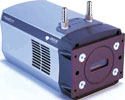Ground-breaking technology for spectroscopy
8 March 2006
Opto-Electronics

Andor Technology (Andor), a leading supplier of specialised cameras and spectrographs for scientific applications, recently notched up another success with the release of the Newton, the first spectroscopic camera to use electron multiplying CCD technology.
EMCCD sensors are manufactured using standard CCD fabrication methods but the unique feature is an electron-multiplying structure that is inserted between the end of the shift register and the output amplifier. The transferring electrons undergo impact ionisation, which generates new electrons and provides multiplication or gain. In many cases this does away with the need to use intensified CCD devices. EMCCD has been hailed as the new ICCD. In effect, the EMCCD is the equivalent of a solid-state image intensifier that does not have the disadvantage of a limited MTBF.
The top-of-the range Newton has a 2048 x 512 array of 13,5 μm pixels and thermoelectric cooling down to -100°C, which results in negligible dark current. Versions are also available with other array formats such as 1600 x 200 or 1600 x 400 using 16 μm pixels. This high resolution spectroscopic sensor, combined with Andor's low noise electronics delivers quantum efficiencies of up to 95% with multimegahertz read out and USB connectivity.
The cameras can be purchased with coatings and windows that maximise performance in various spectral regions. For operation the Newton requires one of Andor's two software options - one for data acquisition and processing, or the other to create one's own applications. Andor software is Windows-based and supports all versions.
Further reading:
Africa’s future internet could be on overland submarine cables
Opto-Electronics
SEACOM aims to explore an innovative new concept: utilising submarine cable technology to address the longstanding challenges in Africa’s terrestrial infrastructure.
Read more...
Versatile range of camera modules
EBV Electrolink
Opto-Electronics
The CAM-66GY pro-modules from ST are a full range of sample camera modules made for a seamless evaluation and integration of the VD66GY 1,5-megapixel colour image sensor.
Read more...
Enhanced breaker status and communication module
Schneider Electric South Africa
Opto-Electronics
Schneider Electric has announced the launch of its new Breaker Status and Communication Module (BSCM) Modbus SL/ULP, which delivers enhanced performance, improved connectivity, and simplified integration for power distribution systems.
Read more...
Heat-resistant LEDs
Opto-Electronics
Würth Elektronik’s new RGB LEDs are characterised by excellent heat resistance with an insensitivity to temperatures from -40 to 100°C making them ideal solutions for reliable, colour-variable lighting in applications at high operating temperatures.
Read more...
PhotoMOS relays
Future Electronics
Opto-Electronics
The AQY221R2SX and AQY221R2S PhotoMOS from Panasonic Industry ensures excellent characteristics and high-speed switching performance.
Read more...
Mouser now shipping onsemi’s image sensors
TRX Electronics
Opto-Electronics
The AR0145CS is a 1/4,3-inch CMOS digital image sensor with a 1280 (H) x 800 (V) active-pixel array that can capture both continuous video and single frames.
Read more...
Adaptive optics’ power solution
Altron Arrow
Opto-Electronics
Vicor power-dense adaptive optical modules enable colossal telescopes to look into the past for deep space discoveries.
Read more...
Ultra-high speed photo detection
Opto-Electronics
TDK Corporation has announced a photo-spintronic conversion element combining optical, electronic, and magnetic elements that can respond at an ultra-high speed of 20 picoseconds.
Read more...
High-speed lasers
RFiber Solutions
Opto-Electronics
Macom are a high-volume manufacturer of lasers, deploying more than 100 million devices with a reliability of less than 50 FIT and greater than 100 years of wear-out lifetime
Read more...
High-performance optical interconnect
Opto-Electronics
STMicroelectronics has unveiled its next generation of proprietary technologies for higher-performing optical interconnect in datacentres and AI clusters.
Read more...


